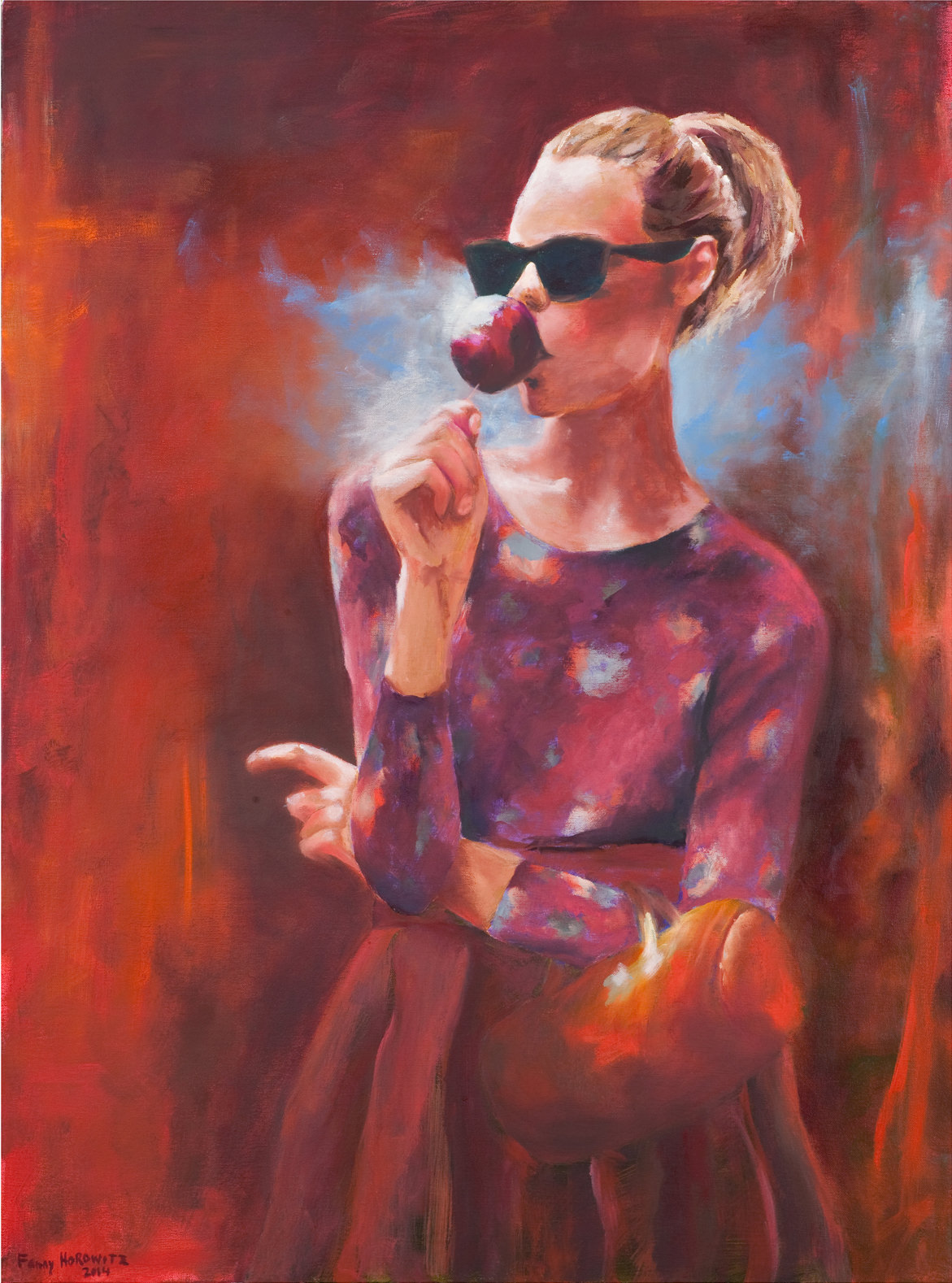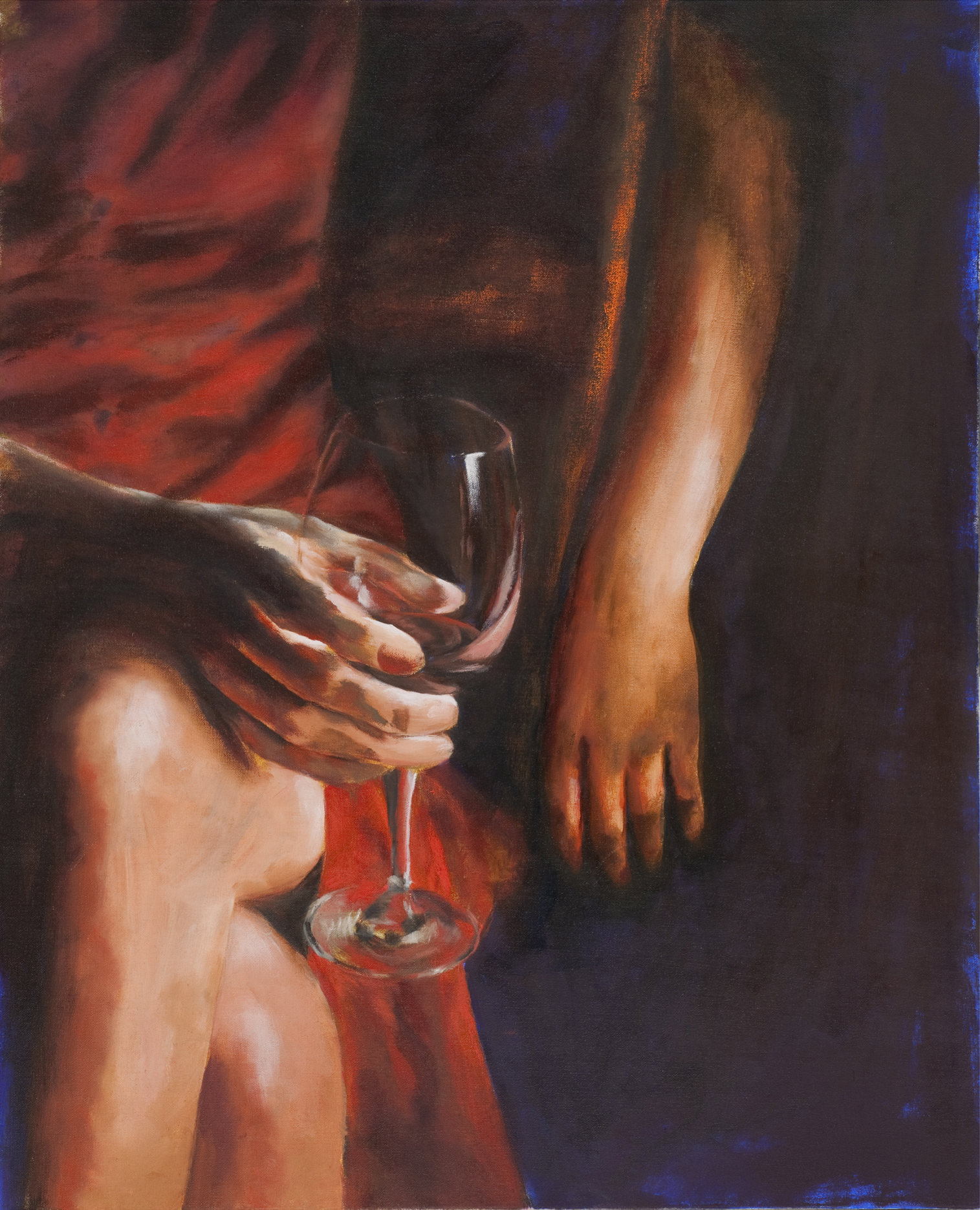Fanny Horowitz explores the role of women in her figurative paintings and the persona that they take on in society.

Fanny Horowitz’s figurative paintings focus on the social persona that women take on in their every day lives. Using technical skills and a love of color, Fanny creates intimate and mysterious worlds in which the viewer can take part.
Leaving the context for her subjects vague, Fanny invites us all to interpret each piece in our own way. While one person might see a woman checking herself out in a mirror, another person may see someone with insecurities, making sure that her makeup or clothes are perfectly in place. “For me, painting is setting out on an adventure. I choose to paint simple and unassuming motifs from the world around me,” says the artist.
Fanny draws inspiration from the Impressionist movement and the intense colors of Fauvism. Her works are drenched with color, with subtle but firm depictions of light and shadow. She uses vivid oil colors and mixes endless shades and sub-shades for each piece. These methods generate a sense of mystery, prompting the viewer’s imagination to form a unique, individual experience.
Those moments of grace that she creates are an escape from a noisy, outside world to a place that is tranquil, allowing the viewer to dive into the depths until they lose their sense of external time and place, entering and observing inner emotional worlds and landscapes, and searching for a lock that opens a door to spiritual sustenance.
We had the chance to sit down with Fanny and discuss her work and process, and we were far from disappointed. Read on to learn more about this fascinating artist!
When I first started painting, I explored my environment from my own personal point of view. By observing the technical aspects of light, shadow and transparency, as well as line, color, and the ways in which colors bounce off of different surfaces, I saw a whole different world around me. I initially started with the paintings of accessories, which led me to explore the social persona of the female. I found photos of women by browsing social media, and then I noticed that on social media, everyone is posing to the watchful eye of society. All those selfies! People portray themselves the way they want others to see them. I continued with this theme because it is amazing to look and see what people want to convey by this social persona that they show.

I started exploring and painting very plain still-lifes from objects that I found around my home. I started with bowls and jewelry and then moved on to my own personal accessories, like a coat, a transparent gown, a bracelet, sunglasses, and stilettos. The endless layers of information, beauty, and mystery that I suddenly revealed, thrilled me to a great extent. It was an amazing new world for me. Looking at all my still life paintings, I suddenly understood that the essence of accessories is to communicate subtle information, to add beauty and mystery, or, in other words, to help create a social persona.
“We usually use accessories more in public than at home, they are status symbols, and we give very profound thought to them, even though we may not admit it.”
Some of them I took myself and some of them I just found on social media and thought, “This is amazing, I must paint it!” By painting, I put a focus on something that I see. Everybody else can see it too, but this is MY particular focus.
I like the mystery it creates. It also leaves space for the viewers to replay the scenes in their own intimate lives. It lets them become emotionally involved in what I’m doing in the space, and when they don’t have to be decisive, it leaves space for them to change their minds when in another mood, to tell themselves other stories. I think that painting is a way of communication. You have a way to touch the soul of someone else. I get very excited when people tell me, ‘Oh, I know that woman!’ or ‘This is me!’ when looking at one of my paintings. They identify with the piece. I’m satisfied to know that it makes them think, laugh, and interact with my art. That is the main point.
If you like art as much as we do, and want to be updated with the latest info about Agora Gallery, our exhibitions, and our artists, don’t forget to sign up for our newsletter!

I think that this way the subjects are able to perform a more intimate dialogue with the viewers. It is more personal when you are one on one, because when you see a group of people, there is something going on inside that you are not a part of.
“I give to simple accessories a status of protagonist playing the leading rile on my canvas, the same significant role that they are playing in the definition of the Social Self of women.”

No, because I don’t aim to inspire any changes in the norms of society towards women. My work is more observational. I just put a mirror in front of all of us, including myself, showing the efforts that we make as women, each of us for her own reasons. I leave space for the viewers to ask themselves questions and answer their own intimate answers. The work is left open for interpretation.

When I was a young child, my grandpa used to play this game where he would ask me math questions and then give me something to paint. For the questions in math, my grades were always high, and for the paintings my grades were lower. Then I would start to cry, and my mother would say ‘What do you care, give her a higher grade!’ and he would say ‘No, she doesn’t deserve it. I won’t give her a better grade if she doesn’t deserve it.’ Maybe this is why I am good at math and pursued it further.

Another angle to look at why I didn’t start painting a long time ago was because my parents were immigrants, and they worked very hard for a living. As a child, seeing that you have to work hard for a living, I think maybe I thought to myself that painting was fun, so you don’t paint for a living. You have to work hard and paint for fun. But a year and a half ago, I quit marketing and branding and started doing art full time.
I think it influences my work because marketing and branding are about communication. That is the world that I’m familiar with. Another thing that I’m sure influences my work is that in marketing, branding, or publishing, you create kind of a disturbance in order to attract the attention of the viewers to give them reason to think, not only just watch what you are doing. If a message goes through their minds in some way, it will have more impact. I never thought about this while painting, but looking at all of the pieces together, I saw some of these themes in there. For example, I painted some women with stiletto shoes that I did not edit, so when someone asks, ‘Why did she leave those stilettos like that?’ Ahh! You are thinking! That is what I want.
“We absorb 83% of a message by sight, and accessories, body language, selfies and the social persona are all ways of non-verbal communication.”
Not showing eyes is another feature. There was someone at the opening who told me, ‘You can never see the eyes but you see where they are looking.’ There’s only one painting where you can see only one eye (“Behind the Veil,” above). So these are some small nuances or disturbances that attract people. You don’t want to talk to somebody with their sunglasses on because it’s hard to communicate that way, but here you have women with sunglasses on and you create communication. You don’t see their eyes but there is communication. I think that there is something in me that I don’t even realize or use until I see the works later. It is intuitive. And then all the vibrant colors and transparencies and contrast between light and shadow that I use, they are all kind of disturbances. My paintings are not quiet.

In my latest work, I painted a young woman, not at all posing, because all those posing women made me think about when we are not posing. From my own experience, nobody can pose when they are doing sports. This last painting was of a women doing a high jump. I look at myself when I’m doing sports, and I’m out there, not interested in what anybody thinks about me because I am with myself. It is nice to be in a quiet world when you don’t have to pose, when you don’t have to think about every other person and what they think about me. When you do sports, you just have to listen to yourself.
Collectors often relate to the art they buy emotionally, and more often than not, it is because they identify with the artist’s process. Whether you are looking to decorate an entire home, complete a room, or add vitality and professional credibility to an office space you will find the perfect piece on ARTmine. Need help in finding the perfect piece that really speaks to you? Contact us at [email protected]
0 thoughts on “Exploring the Social Persona – Fanny Horowitz”